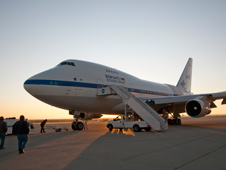 Ground crewmen approach NASA’s SOFIA flying observatory shortly after the modified Boeing 747SP carrying a 100-inch telescope landed following an all-night astronomical observation mission. (NASA / Carla Thomas) › View Larger Image WASHINGTON – NASA has selected a science instrument upgrade to the Stratospheric Observatory for Infrared Astronomy (SOFIA) airborne observatory. The instrument, the High-resolution Airborne Wideband Camera (HAWC), will provide a sensitive, versatile and reliable imaging capability to the SOFIA user community. The upgrade involves two proposals that will allow the observatory to measure the structure and strength of magnetic fields in diverse objects throughout the universe, such as star-forming clouds and galaxies. This will help astronomers better understand how stars, planets and galaxies form and evolve.
Ground crewmen approach NASA’s SOFIA flying observatory shortly after the modified Boeing 747SP carrying a 100-inch telescope landed following an all-night astronomical observation mission. (NASA / Carla Thomas) › View Larger Image WASHINGTON – NASA has selected a science instrument upgrade to the Stratospheric Observatory for Infrared Astronomy (SOFIA) airborne observatory. The instrument, the High-resolution Airborne Wideband Camera (HAWC), will provide a sensitive, versatile and reliable imaging capability to the SOFIA user community. The upgrade involves two proposals that will allow the observatory to measure the structure and strength of magnetic fields in diverse objects throughout the universe, such as star-forming clouds and galaxies. This will help astronomers better understand how stars, planets and galaxies form and evolve.
SOFIA is a highly modified Boeing 747SP aircraft that carries a telescope with a 100-inch (2.5-meter) diameter reflecting mirror that conducts astronomy research not possible with ground-based telescopes. By operating in the stratosphere at altitudes up to 45,000 feet, SOFIA can make observations above the water vapor in Earth’s lower atmosphere.
“SOFIA has the ability to become a world-class airborne observatory that complements the Hubble, Spitzer and Herschel space telescopes,” said John Grunsfeld, NASA’s Science Mission Directorate associate administrator. “This upgrade will greatly broaden SOFIA’s capabilities.”
Last August, the agency released an Announcement of Opportunity for SOFIA second-generation instrument investigations and received 11 proposals. The selected proposals were judged to have the best science value and feasible development plans.
The selected proposals are:
– The High-resolution Airborne Wideband Camera Polarization (HAWC-Pol), Charles Dowell, principal investigator, NASA’s Jet Propulsion Laboratory, Pasadena, Calif. This investigation upgrades the HAWC instrument to include the capability to make polarimetric observations at far-infrared wavelengths. The investigation’s main goals are to measure the magnetic field in the interstellar medium, star forming regions and the center of the Milky Way.
– HAWC++, Johannes Staguhn, Johns Hopkins University, Baltimore. This investigation will provide a sensitive, large-format detector array to the HAWC-Pol investigation, increasing its observing efficiency and providing a broader range of targets.
SOFIA is a joint project of NASA and the German Aerospace Center and is based and managed at NASA’s Dryden Aircraft Operations Facility in Palmdale, Calif. NASA’s Ames Research Center at Moffett Field, Calif., manages the SOFIA science and mission operations in cooperation with the Universities Space Research Association, headquartered in Columbia, Md., and the German SOFIA Institute at the University of Stuttgart.
For more information about the SOFIA program, visit:
– end –
text-only version of this release
NASA press releases and other information are available automatically by sending a blank e-mail message to hqnews-subscribe@mediaservices.nasa.gov. To unsubscribe from this mailing list, send a blank e-mail message to hqnews-unsubscribe@mediaservices.nasa.gov.
Back to NASA Newsroom | Back to NASA Homepage
J.D. Harrington
Headquarters, Washington
202-358-5241
j.d.harrington@nasa.gov


























